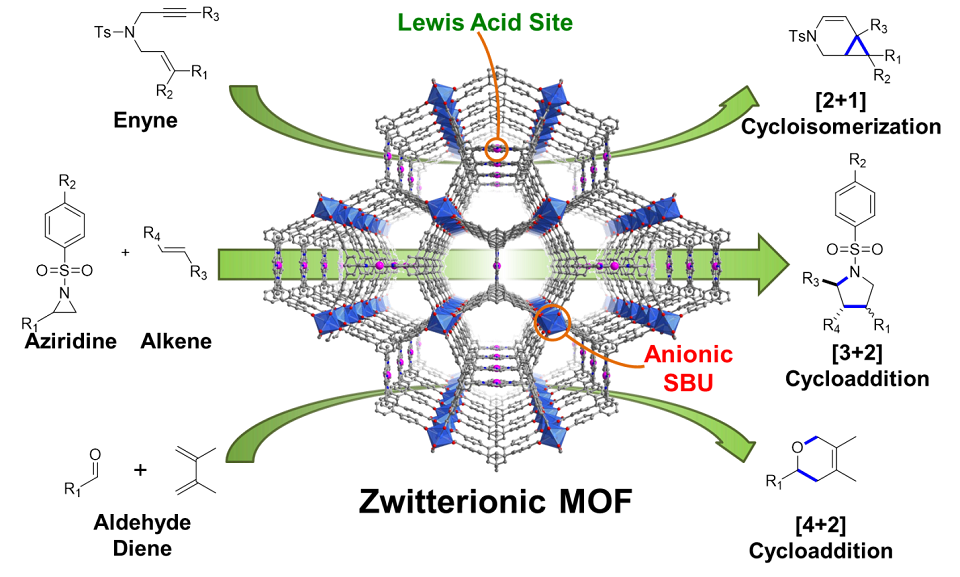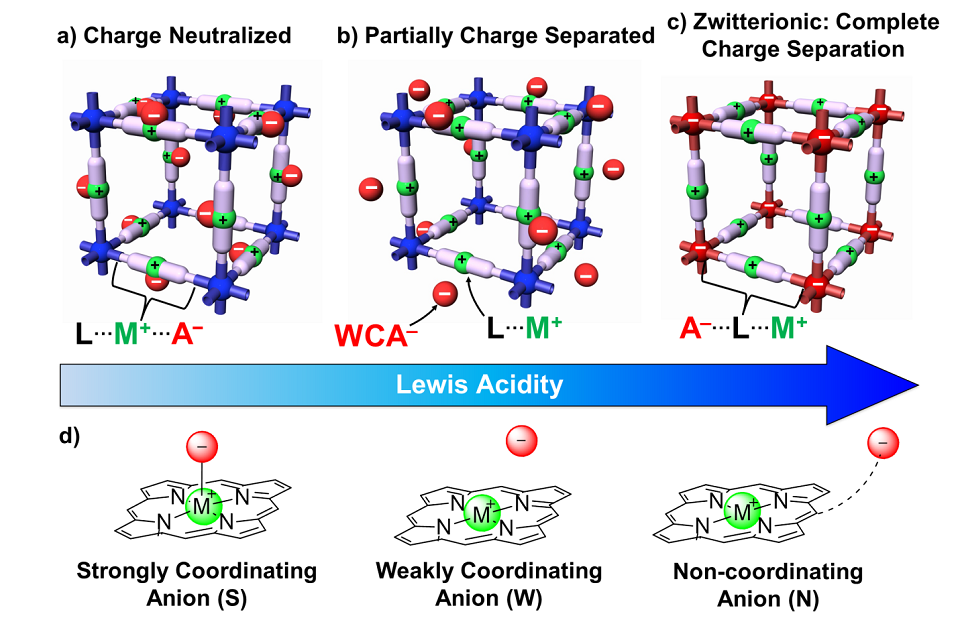
Assistant Professor Jian Zhang and his colleagues have designed a strategy to enhance the Lewis acidity of metalloporphyrins within a metal-organic framework. In this recent work, they describe preparation of zwitterionic metalloporphyrinic MOFs and further demonstrate their enhanced catalytic activity toward electrocylcization reactions.
Cationic transition metal complexes are frequently employed as Lewis acids to promote organic reactions, during which the ion pairing interaction between the metal center and the counter anion significantly affects the activation of substrates and catalytic activity in general.1 Frequently, weakly coordinating anions (WCAs), are used to increase the electrophilicity of the Lewis acid sites.2 Another attractive approach involves the use of zwitterionic metal complexes, in which a cationic organometallic fragment and a negatively charged ancillary ligand are covalently bonded together to achieve a formal charge separation. The internal charge neutralization and tunable electrophilicity of zwitterionic metal complexes has been particularly appealing for a variety of catalytic reactivity studies.
Metal-organic frameworks (MOFs) are a class of highly porous crystalline solid materials that have found vast application potential in chemical catalysis.3 MOFs consist of inorganic SBUs (secondary building units) and organic linkers, both of which can be constructed to exhibit a net ionic charge. It is therefore conceivable to prepare zwitterionic MOFs (i.e. a cationic ligand may be combined with an anionic SBU). Importantly, in such zwitterionic MOFs the anionic SBU is inherently “non-coordinating”, which results in an enhanced Lewis acidity of the cationic metal center in the organic linker (Figure 1c). Zwitterionic MOFs should also compare favorably to MOFs that are composed of cationic metalloligands with extraframework WCAs in which only the partial charge separation is achieved (Figure 1b). 
Zhang and coworkers performed a proof of concept study by synthesizing porphyrinic MOFs4 that are comprised of anionic [In(CO2)4]– SBUs and cationic metalloporphyrin linkers. They demonstrate that, with an increased net positive charge in the cationic metal center, such zwitterionic MOFs exhibit enhanced catalytic activities for three representative electrocyclization reactions: [2+1] cycloisomerization of enynes, [3+2] cycloaddition of aziridines and alkenes, and [4+2] hetero-Diels-Alder cycloaddition of aldehydes with dienes.5 Due to the increased Lewis acidity of the porphyrin metal center, the zwitterionic MOFs indeed afford higher reaction yields as well as an improved chemo-, and/or regioselectivity in all three reactions. The change in terms of electronic structure considerably affects the activation of substrates and lowers the activation barrier of the subsequent transformation steps in three representative electrocyclization reactions. This study paves a new way for designing functional charge separated MOFs for tunable chemical catalysis, which is currently underway in the Zhang lab.
This study is published in JACS and is viewable at:
https://pubs.acs.org/doi/abs/10.1021/jacs.6b05626
References:
1. Macchioni, A. Chem. Rev. 2005, 105, 2039-2073.
2. Krossing, I.; Raabe, I. Angew. Chem. Int. Ed. 2004, 43, 2066-2090.
3. Lee, J.; Farha, O. K.; Roberts, J.; Scheidt, K. A.; Nguyen, S. T.; Hupp, J. T. Chem. Soc. Rev. 2009, 38, 1450-1459.
4. Gao, W.-Y.; Chrzanowski, M.; Ma, S. Chem. Soc. Rev. 2014, 43, 5841-5866.
5. Fujiwara, K.; Kurahashi, T.; Matsubara, S. J. Am. Chem. Soc. 2012, 134, 5512-5515.



